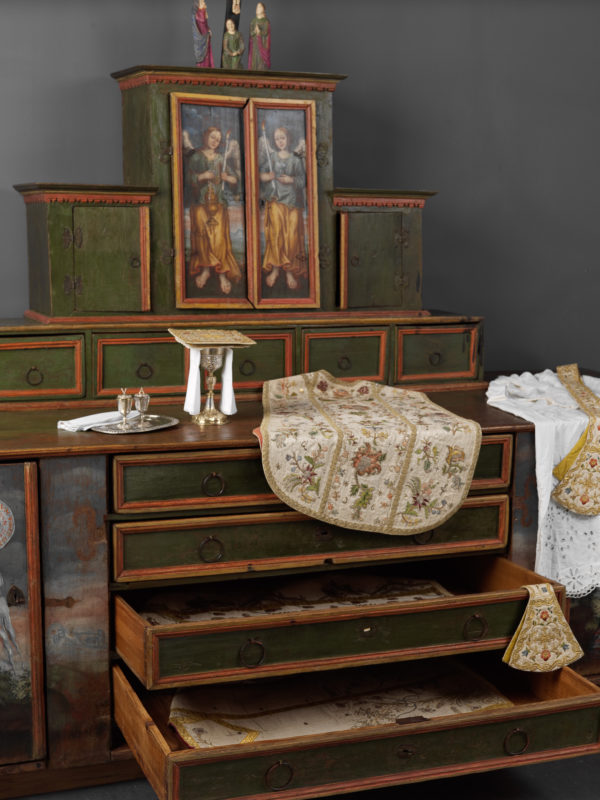Sacristy credens – from the Museum’s collections
Slovak National Museum – Historical Museum presents objects from its depositories
This time it is a sacristy credens or paramentary, which the museum acquired into its collections in 2008. It was in poor condition, so it was subsequently completely restored. Today, this sacral furniture is displayed on the 1st floor of the Bratislava Castle in front of the Music Hall.
The sacristy credens is a closable furniture – a cabinet, similar to a chest of drawers or a secretary, with a door for locks, which serves for storing liturgical garments and objects. Liturgical objects are kept in the sacristy, a side temple room, where a priest with assistance prepares for the celebration of the service.
The Trident Council (1545 – 1563) issued guidelines for the installation of Roman Catholic sacristies, according to which the sacristy should contain a table, kneeling and before it the text of prayers before Mass and after Mass; a cross, the image of the bishop and the pope, a washbasin with a towel, where the priest washed his hands before the liturgy as well as a sacristy credens.
The exhibited temple furniture represents a two-storey tabernacle paramentary type with two side cabinets. At the bottom, it impresses with its painting decoration of rustic but cultivated artistic expression. Table paintings with the motif of angels on the door of the lower cabinets and in the extension make a fairly common home joinery work artistically impressive. The panel paintings are used secondary, they were adapted to the structure of the drawer middle part of the chest of drawers, which was also confirmed by restoration research. They probably come from the extinct altar of the Roman Catholic church in Čimhová.
Two angels on the wing doors of the lower cabinets hold in their right hand a fire sword and in their left hand standards that also perform the function of bandelore, i.e. an inscription tape with biblical text in Latin, which is sometimes illegible. On the angel’s inscription tape on the left door there is a text from the Gospel according to Luke (11, 21): Cum fortis armatus custodit atrium suum, in pace sunt ea, quae possidet [“When a strong armed man is guarding his court, his possessions are safe”] On the angel’s inscription tape on the right door there is a part of the text from the Book of Exodus ( 23, 20 – 23) and a link to the source: NEC ContemnedEUM PUTES: quia NON dimitet CUM PECCAVERIS: EXOD: XXIII. [… and “do not contradict him, because he does not forgive your sins”]. This inscription is probably just a fragment or rather a continuation of the more continuous text that preceded it on today’s unpreserved door overlapping the drawer – chest of drawers middle part of the paramentary.
The tabernacle box in the upper graduated part of the paramet has a door painted by angels with burning candles in their left hand, while in the right they hold representatives of liturgical objects – incense and navicula – which are kept in the upper part of the parametre. The cabinet is painted inside: on the inside of the door and on the back panel there is a painting evoking the heavenly sky with golden stars on a blue background along with Christ’s monogram IHS in a beam-shaped halo. The painting corresponds to the place to store the monstrance. Even the side cabinets are painted on the inside. The internal painting of the boards was uncovered in the restoration process.
According to Christian iconography, angels depicted in the form of young men with wings, fiery swords, candles and other attributes are God’s messengers, ready to protect all God’s creatures from evil and to announce the last judgment. Angels on the paramentary also have a symbolic role of guardians of sacred liturgical objects stored in it.
